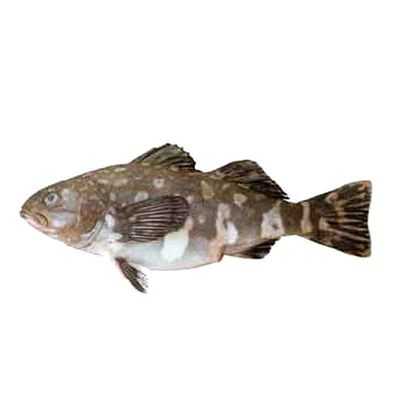Skilfish

Species Details
Erilepis Zonifer
Anoplopomatidae
Scorpaeniformes
Continental Shelves, Rocky Bottoms
20 - 200 lbs.
36" - 72"
What is the Skilfish?
The skilfish is a jet-black-colored bottom-dwelling fish that prefers the colder waters of the northern hemisphere. It lives deep in the ocean, usually on rocky terrains where it forages for its food of mostly crustaceans. Its preference for rocky habitats is also for survival as these underwater structures provide protection against predators.
Skilfish (Erilepis zonifer) Description
Also known as a Black Cod, the Skilfish is a jet-black colored fish with white blotches covering its body. It has smaller white spots on its dorsal and anal fin. The Black Cod, although they look similar, has no relation to the one they call the Sablefish. As they grow older, however, their skin turns from black to dark grey. The blotches also on the Skilfish also begin to fade.
Skilfish looks like what would have been the lovechild between a Wreckfish and a Sea Bass. They have large eyes and a cavernous mouth similar to that of the Sea Bass.
Diet and Size
Skilfish are surface feeders. Since their lips have a terminal configuration, Skilfishes are known for snapping their jaws at bony fishes. Some of these fishes can include eels, capelin, Pacific Cod, Pollock, Mackerel, Herring, and Mullets. They also feed on Cephalopods like squids and octopi. Depending on their mood, Skilfish might even go for the occasional crustacean like a shrimp and small crab. Jellyfishes to them are also a pretty good treat.
There have been reports however that Skilfish are also known to feast on Rockfish.
Skilfishes can get quite big. They can grow up to 6 feet and weigh up to 200 lbs! However, on average, Skilfishes grow up to 3 feet and weigh around 20 lbs. As a deep-dwelling fish, it’s quite difficult to gain an average range as to how big the Skilfish can grow.
Interesting Facts about the Skilfish
- Skilfish is from a pretty old race of fish. Some say they can reach over 90 years old.
- On average, however, they only live up to 20 years.
- Skilfish despite their age are considered harmless.
- Sablefish and Skilfish are often mistaken for one another.
- The Sablefish has two dorsal fins whereas the Skilfish only has one and it’s nearest to its tail.
- The Skilfish is part of an order known as the Mail-Cheeked fish. Its third circumorbital bone extends backward whereas, for most fish, it’s connected.
- The Skilfish is in the same group as the Lionfish.
- Scorpaeniformes, the order the Skilfish is from, has the most members. All in all, there are 1,320 species under that order.
Fishing Techniques: How to Fish for a Skilfish
Unfortunately, catching a Skilfish is no joke. And sometimes, you might end up catching a Sablefish instead. However, you can take the general approach of going deep-sea fishing.
Deep-Sea Fishing is a technique wherein you sail out to the open waters. As you travel into the open waters, you’ll have to be more attentive to the signs in nature. One of the indicators would be if there’s a bunch of seagulls flying over your head. Seagulls mean there are small fish and if there are small fish, the big fish will soon come out to play. The Skilfish will definitely come in when they see that the school of fish swimming around there are either Mackerel or Pollock. These are one of their more particular favorites and you can also catch these to serve as cut bait.
Another place to check is the rocky reefs. Sometimes, you’ll find some eel hanging around there which is also another part of the Skilfish’s diet. Consider also that because they’re dark-colored, they may also be lurking among the rocky bottomed areas especially where they can find an abundant amount of crab and squids.
Habitat and Distribution
Skilfishes have a preference for deep waters especially those with rocky bottoms. To them, rocky bottoms are the best place to find smaller crustaceans and crabs. Being among the rocky bottoms also allows Skilfishes to hide from their enemies. Their bodies are also not used to sudden changes of pressure so when hauling out a Skilfish, best to do it slowly. Yanking them out of the water might just kill them in the process.
Skilfishes however appear to like cold waters. They usually migrate to Japan from Alaska, usually hanging up north. As for their light preference, Skilfish stay in the bottom. So, that might mean that they don't really like staying near the surface nor do they like the light. Skilfish also like staying in crevices especially in Monterey Bay where the light is adjusted for them. Saltwater is sometimes pumped into their habitat for them to better adjust to the waters.







